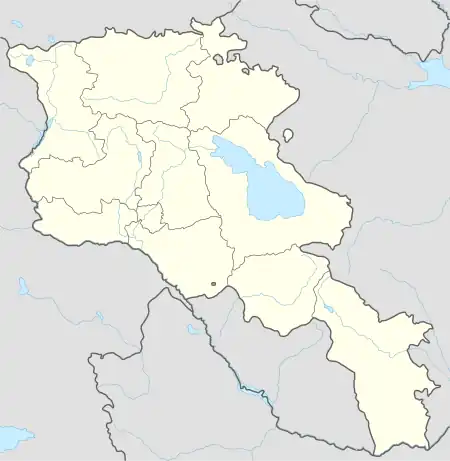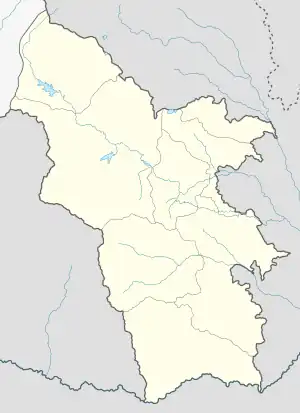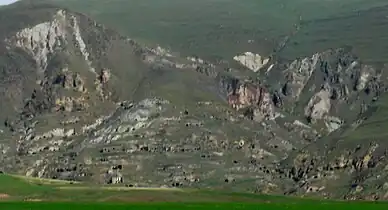Tegh
Տեղ | |
|---|---|
 Tegh  Tegh | |
| Coordinates: 39°33′17″N 46°28′33″E / 39.55472°N 46.47583°E | |
| Country | Armenia |
| Province | Syunik |
| Municipality | Tegh |
| Population | |
| • Total | 2,443 |
| Time zone | UTC+4 (AMT) |
| Tegh at GEOnet Names Server | |
Tegh (Armenian: Տեղ) is a village and the center of the Tegh Municipality of the Syunik Province in Armenia. Tegh is the last village on the Goris-Stepanakert Highway before passing the border with the Republic of Artsakh.
Of significance in the village, are the dozens of visible caves present near Tegh. The village is underlaid by a soft stone layer of porous rock, replete with rows of caves that were once used for human habitation, now largely used for animals. There are also some very large ones facing highway M12. Rows of them are visible from the highway while driving east.
It is located in the central-eastern part of the province, a short distance from the Vorotan River - a tributary of the Aras River, which, in turn, is a tributary of the Kurá - and the border with Azerbaijan.
The surrounding areas of the village are currently being occupied by Azerbaijan as of March 31st 2022[2]
Etymology
The name of the village comes from its Old Armenian name of Տեղ (Teł), first mentioned by Stepanos Orbelian in the 11th century, which evolved into its modern name of Տեղ (Teġ).[3] It is an Armenian word meaning place or locality (see տեղ for further etymological development).[4] In certain Turkic and Russian sources of the 19th century, the name is spelled Dyg, which is the turkicized pronunciation of the native Armenian name.[5]
History

The oldest structure of the village is the St. Gevorg Church, an Armenian Apostolic church built partly in the 4th-5th centuries while the rest was built in 1737. The settlement of Tegh was originally part of the Haband gavar (district) of the historical Syunik province of the Kingdom of Armenia.[3] According to medieval Armenian historian and Syunik native Stepanos Orbelian, the village was founded by Armenian Queen Shahandukht, ruler of the lands of Syunik, who gifted it to the Tatev Monastery in 998 AD in honor of her late husband, King Smbat of Syunik.[6][7] Tegh is mentioned in the old tax records of the 13th century as paying 12 units (drams) to the Tatev Monastery.[3]
.jpg.webp)
At the beginning of the 18th century, the region was the centre of the Armenian liberation campaign led by David Bek against Safavid Persia and the invading Ottoman Turks. Due to the Syunik rebellion, Tegh again returned to Armenian rule under the Principality of Kapan (1722-1730).[8] In particular, Tegh was the birthplace of Melik (prince) Barkhudar, the prince of Tegh and an Armenian commander at the forefront of the Armenian liberation movement alongside David Bek. In 1748, Melik Barkhudar’s son, Davit Bek Melik-Barkhudaryan, named after his fathers comrade, succeeded his father to the Melik throne and continued to locally rule Tegh until the end of the century.[7] By 1750, the region again fell under Iranian suzerainty as part of the newly-formed Karabakh Khanate.[8] The local prince Davit Bek Melik-Barkhudaryan built his palace in the village of Tegh in 1783 from where he ruled the village and its surroundings. The Armenian inscription on the palace reads:[7]
ԹՎ ՌՄԼԲ (1783) Ի վաելուսն Մէլիք Բարխուդարի որթի Դավիթ Պէկս Շինեցի այս ամարաթս Իբրայիմ խանի ժամանակօվ [TV RMLB (1783) I Melik Barkhudar's son, Davit Bek, built this Amarath in the time of Ibrahim Khan.]
At the turn of the century, Tegh became part of the Russian Empire as a result of the Treaty of Gulistan signed on 24 October 1813 between Russia and Qajar Iran following the Russo-Persian War of 1804–13. In 1823, Russian general Aleksey Petrovich Yermolov mentions Tegh in his description of the Karabakh province as an ethnically Armenian village with 111 tax-paying households.[9] In the middle of the 19th century, the village was one of the largest in the province. The settlement at that time had 1,454 residents. The village itself had 240 courtyards, an Armenian church, and an oil mill.[5] By 1893, the settlement had 472 households, and the population, entirely consisting of Armenians, numbered 3,159 inhabitants.[10] Following the dissolution of the Russian empire, the region of Syunik was under dispute between the first republics of Armenia and Azerbaijan. On April 27, 1921, the region of Syunik was declared part of the Republic of Mountainous Armenia during the 2nd Pan-Zangezurian conference held in Tatev. However this republic was short-lived and by July of that year it was incorporated into the Soviet Union with the promise that it would become part of Soviet Armenia.[11] While it was under Soviet rule, Tegh was part of the Goris district of the Armenian SSR. It was a center of industry and carpet making, being home to one of the Haygorg carpet factories of Armenia. Following the dissolution of the Soviet Union, Tegh is now part of the Syunik Marz of the Republic of Armenia.[3]
Demographics
Population
The Statistical Committee of Armenia reported its population was 2,520 in 2010,[12] up from 2,333 at the 2001 census.[13]
Gallery
 "Cave City" in Tegh
"Cave City" in Tegh Residential complex "Amarath" of the Melik-Barkhudaryans (1783)
Residential complex "Amarath" of the Melik-Barkhudaryans (1783) School in Tegh
School in Tegh Khachkar monument in memory of the victims of the First Nagorno-Karabakh War
Khachkar monument in memory of the victims of the First Nagorno-Karabakh War.jpg.webp) Saint George's Church in Tegh
Saint George's Church in Tegh
References
- ↑ Statistical Committee of Armenia. "The results of the 2011 Population Census of Armenia" (PDF).
- ↑ @301arm. "Argam Hovsepyan, the administrative head of the Aravus settlement and a member of the "Country to Live" faction of the Council of Elders, reported that Azerbaijani troops had crossed the border of Armenia and entered the community of Tegh".
{{cite web}}: CS1 maint: numeric names: authors list (link) - 1 2 3 4 5 6 Hakobyan, Melik-Bakhshyan & Barseghyan 2001, p. 71.
- ↑ Acharian 1913, p. 1022.
- 1 2 Semenov 1865, p. 150.
- ↑ Orbelian 1859, pp. 34–37.
- 1 2 3 Ghulyan 2001, pp. 109–110.
- 1 2 Dum-Tragut 2018, pp. 107–108.
- ↑ Yermolov 1866, p. 149.
- ↑ Martirosyants 1893, p. 248.
- ↑ Panossian 2006, p. 259.
- ↑ "Marzes of Armenia and Yerevan City in Figures, 2010" (PDF). Statistical Committee of Armenia.
- ↑ Report of the results of the 2001 Armenian Census, Statistical Committee of Armenia
Bibliography
- Acharian, Hrachia (1913). "տեղ [tegh]". Ēminean azgagrakan zhoghovatsu [Emin Ethnographic Collection: Armenian Provincial Dictionary] (in Armenian). Vol. 9. Tbilisi: Lazarev Institute of Oriental Languages. p. 1022.
- Dum-Tragut, Jasmine (2018). "Syunik from the 17th century until Soviet Period". In Winkler, Dietmar W. (ed.). Monastic Life in the Armenian Church: Glorious Past - Ecumenical Reconsideration. Zurich: LIT Verlag. pp. 107–108. ISBN 9783643910660.
- Ghulyan, Artak (2001). "Տեղ [Tegh]". Castles (Palaces) of Meliks of Artsakh and Siunik (PDF). Research on Armenian Architecture. Vol. 4. Yerevan: "Gitutiun" Publishing House of NAS RA. pp. 109–114. ISBN 5-8080-0469-1.
- Hakobyan, Tadevos Kh.; Melik-Bakhshyan, Stepan T. [in Armenian]; Barseghyan, Hovhannes Kh. [in Armenian] (2001). "Տեղ [Tegh]". Հայաստանի եւ հարակից շրջանների տեղանունների բառարան [Dictionary of place names of Armenia and neighboring regions]. Vol. V. Yerevan: Yerevan State University Press. p. 71.
- Martirosyants, I. (1893). Свод статистических данных о населении Закавказскаго края, извлеченных из посемейных списков 1886 г. [A set of statistical data on the population of the Transcaucasian region, extracted from family lists in 1886] (in Russian). Tbilisi: Transcaucasian Statistical Committee.
- Orbelian, Stepanos (1859). Shahnazaryan, Karapaet [in Armenian] (ed.). Patmutʿiwn nahangin Sisakan [History of the Province of Siwnikʿ (Šar hay patmagracʿ)] (in Old Armenian). Paris: K. Šahnazareancʿ. pp. 34–37.
{{cite book}}: CS1 maint: unrecognized language (link) - Panossian, Razmik (2006). "The Independent Republic and Sovietisation". The Armenians: From Kings and Priests to Merchants and Commissars. New York: Columbia University Press. p. 259. ISBN 9780231139267.
- Semenov, P. (1865). "Dyg". Geographic and Statistical Dictionary of the Russian Empire (in Russian). Vol. 2. St. Petersburg. p. 150.
{{cite book}}: CS1 maint: location missing publisher (link) - Yermolov (1866). Opisaniye Karabakhskoy provincii sostavlennoye v 1823 g po rasporyazheniyu glavnoupravlyayushego v Gruzii Yermolova deystvitelnim statskim sovetnikom Mogilevskim i polkovnikom Yermolovim 2-m [Description of the Karabakh province prepared in 1823 according to the order of the governor in Georgia Yermolov by state advisor Mogilevsky and colonel Yermolov 2nd]. Tbilisi.
{{cite book}}: CS1 maint: location missing publisher (link)





